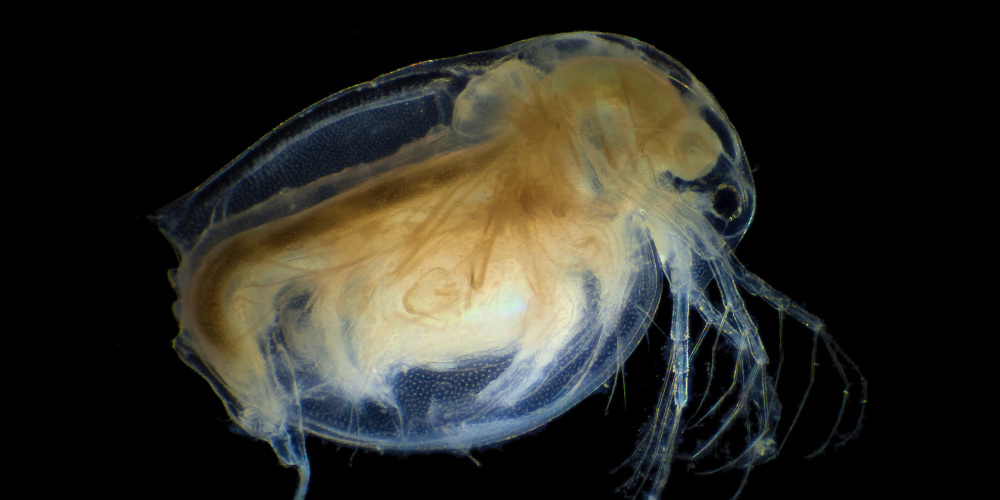Daphnia, a valuable organism for quality ecotoxicological research
Ecotoxicology focuses on understanding the effects of toxins and environmental contamination on organisms. The ultimate goal of this discipline is to reveal and predict the effects of contamination. Based on the knowledge obtained, effective measures can be taken to prevent or remediate detrimental effects.
Ecotoxicology studies the effects of stressors across all levels of biological organization from the molecular to whole communities and ecosystems. It is a multidisciplinary field that integrates toxicology and ecology.
Daphnia in ecotoxicology research
Daphnia (also called “water flea”) is a very common organism in ecotoxicology research. In the wild, it lives in freshwater ecosystems such as lakes and ponds. It swims in a very particular manner, which is responsible for its common name: a regular beating with a set of antennae that leads to characteristic hops. Various factors such as light, temperature, presence of food, predators or presence of substances in water, including toxins and contaminators, may affect daphnia’s swimming activity. Due to its characteristics, daphnia can easily live in laboratory conditions, contributing to the suitability of this animal for laboratory research.
Basic toxicological research with daphnia is based only on the mortality of the individuals (to evaluate lethal concentration) or on the immobilization of the individuals (to evaluate effective concentration). However, there are more sensitive biomarkers available, such as swimming activity. Mobility in daphnia is affected by many substances, for which it is a very useful indicator of behavioral alteration caused by toxins.
What do we study?
Daphnia’s swimming behavior is very complex, which makes it a very sensitive biomarker of toxicity. Different parameters of the swimming activity can be studied. Each of them can reflect different alterations based on the compound examined. There is an extended body of scientific literature regarding the effects of particular substances on daphnia activity.
The most studied parameters of daphnia’s swimming activity are the following:
- Swimming time: time during which daphnia can move.
- Swimming speed: a measure of the speed of swimming; one of the most reliable and widely used parameters.
- Behavioral strength: the intensity displayed in behavior parameters of instantaneous movement.
- Hopping frequency: number of hops per minute.
- Horizontal distribution: number of daphnia per square centimeters or meters, or the percentage of time spent in a region of water; indicates collective response to different environmental factors.
- Vertical distribution and migration: assessment of the depth at which animals are aggregated.
- Time ratio of vertical to horizontal swimming: an index of which type of swimming dominates.
- Distance traveled: distance moved by daphnia during a certain time lapse (usually in millimeters); indicates locomotor activity.
- Swimming trajectory: pathway left by the movement of daphnia; characterized by length (usually in millimeters) and shape.
- Number of turnings/ turning angle: change in swimming direction.
- Resting time/ duration of quiescence: temporal immobilization followed by a return to normal swimming.
- Sinking rate: Short moments of sinking, which occur between hops.
- Gravitaxis: downward movement engaged in the presence of stressful factors.
- Swarming: collective behavioral response leading to vortex formation.
- Spinning: moving in small circles; characteristic in the presence of stressful factors.
From the list above, it can be seen that swimming behavior in daphnia is an incredibly rich parameter for the study of ecotoxicology. Different substances can affect many of the mentioned parameters in different ways.
The best tool for daphnia activity research
Due to the subtlety in the behavioral alterations that need to be evaluated, and to the need for constant monitoring to detect those changes, the use of specialized software is really recommended. Most of the changes in behavior and the differences between animals of different experimental groups may not be noticed by naked-eye observation. Thus, ViewPoint has developed special equipment for the study of daphnia activity.
ViewPoint technology can monitor the behavior of groups of daphnia contained in up to 20 tanks at the same time and during several hours or days. The system includes the ZebraLab software package, a complete system for high-throughput tracking and behavioral analysis, along with a chamber for daphnia. The system ensures controlled experimental conditions, which are the key for reliable results. The results are, then, provided in comprehensive spreadsheets and charts to assist with the interpretation phase of the study.
Most of the above mentioned parameters of daphnia activity, such as distance traveled, swimming trajectory, position in the tank and number of active organisms, are analyzed in real time to allow for evaluation of the compounds of choice.
The evaluation of water toxicity, which is made easy by daphnia activity evaluation, is tremendously necessary in several scenarios. For instance, it is fundamental when developing new compounds that can impact on the quality of water, or when analyzing samples of water from rivers, lakes or water treatment plants.
Being daphnia such a valuable organism in ecotoxicology, the use of a monitoring system such as the one provided by ViewPoint is fundamental for quality ecotoxicological research.
References
1. chemosphere.2019.124390. Epub 2019 Jul 17. Life history and behavior effects of synthetic and natural dyes on Daphnia magna
Flavia R Abe 1, Ana L Machado 2, Amadeu M V M Soares 3, Danielle P de Oliveira 4, João L T Pestana 5
2. Environmental Science and Pollution Research Phytoremediation processes of domestic and textile effluents: evaluation of the efficacy and toxicological effects in Lemna minor and Daphnia magnaGilberto Dias de Alkimin, Cintia Paisio, Elizabeth Agostini & Bruno Nunes
3. Research Square, February 2021 Acute Adverse Effects of Metallic Nanomaterials on Cardiac and Behavioral Changes in Daphnia Magna Park J, Park CG, Sung B, Lee YO, Ryu CS, Park JY, Kim YJ
4. Environmental Toxicology and Pharmacology, February 2020, Multi-parametric analysis of ciprofloxacin toxicity at ecologically relevant levels: Short- and long-term effects on Daphnia magna
5. MDPI- Biomolecules August 2020 Multiple Screening of Pesticides Toxicity in Zebrafish and Daphnia Based on Locomotor Activity Alterations Akhlaq Hussain 1, Gilbert Audira 1 2, Nemi Malhotra 3, Boontida Uapipatanakul 4, Jung-Ren Chen 5, Yu-Heng Lai 6, Jong-Chin Huang 7, Kelvin H-C Chen 7, Hong-Thih Lai 8, Chung-Der Hsiao
Related Products





